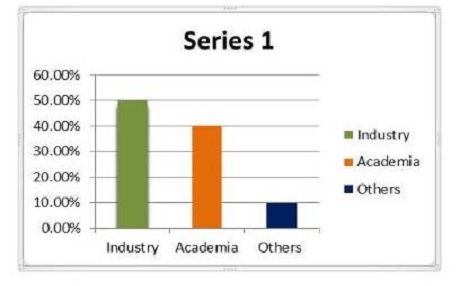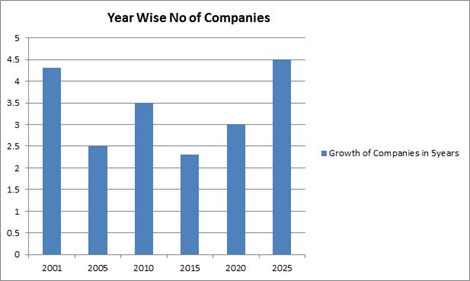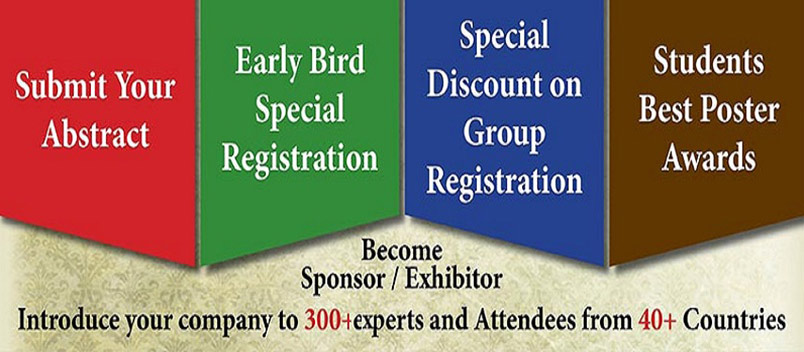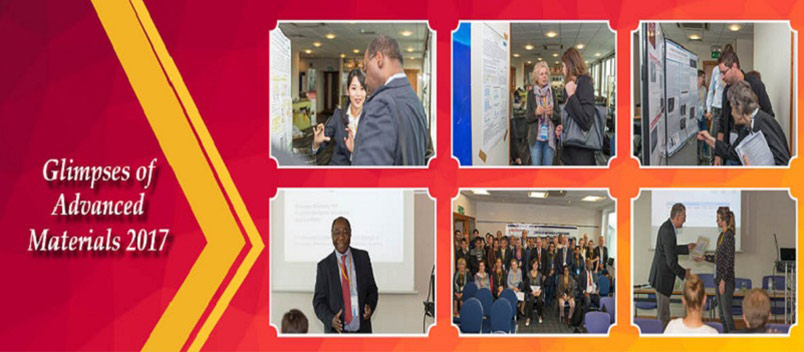Advanced Materials 2018
About Conference
Euroscicon invites all the participants from all over the world to attend International Conference on Advanced Materials and Simulation, during Dec 10-12, Rome, Italy, which includes prompt keynote presentations, Oral talks, Poster presentations and Exhibitions.
Advanced Materials 2018 Euroscicon is an International Conference in the field of material science and nanotechnology organized by Euroscicon during December 10-12, 2018, at Rome, Italy. The goal of Advanced Materials 2018 Euroscicon is to provide a global platform for researchers and engineers coming from academia and industry to present their research results and activities in the field of fundamental and interdisciplinary research of material science and technology. The congress brings together the professors, researchers, scientists, business giants, and technocrats to offer an international platform for the dissemination of original research results, new ideas and practical development and discover advances in the field of advanced materials and related interdisciplinary topics. The conference will also include topics such as classroom demonstrations, new teaching methods, and recent advances in specialized areas of materials science. In addition to the invited talks, there will be oral presentations, posters, and workshops. The theme of conference is “Innovating for the future: Progress on the grand challenges in the Stream of Material Science.”
The Material Science Market is segmented by technology, product, and end user. The market, by technology, is further segmented into additives manufacturing, construction materials, polymer science, and nanotechnology. The Nanotechnology segment accounted for the largest share of the material science market in 2012. However, the simulation of material processing market will see the highest growth in the next few years. The impact of nanotechnology on the field of electronics is far reaching. Although advances in silicon technology continue to revolutionize micro/ Nano electronics, there are cases where non-Si device and component technologies provide superior performance. With modern material growth techniques, it is possible to grow and fabricate multilayered Nano-structures and devices comprising of different materials with Nano scale thickness. Further, nanotechnology-enabled sensors are providing new solutions in physical, chemical and biological sensing that enable increased detection sensitivity, microsystems integration capability and portability for wide variety of health safety and environmental assessments. On the basis of technology, the nanotechnology segment will account for the largest share of the market in 2021.
This event will focus on Application of Nano materials and nanotechnology, Simulation of materials and other related sources, Fiber composites, Automotive and aeronautic structures, Biomaterials and adhesives, Nano photonics in Materials Science, Electrical, optical and magnetic materials , Nanotechnology Applications through invited plenary lectures, symposia , workshops, invited sessions and oral and poster sessions of unsolicited contributions.
Maximize your personal involvement, engagement by getting together on Dec 10-12, 2018 with an interactive discussions and workshops at the conference, you will feel free to reach out and share your thoughts to continue your lifelong learning and build on the skills that make you successful.
Market Analysis
SUMMARY
The International conference on Advanced Materials and Simulation is the platform to gain or share the knowledge in the new technological developments in the field of science, engineering and technology. This conference brings together professors, researchers, scientists, students in all the areas of material science and nanotechnology and provides an international forum for the spreading of approved research. We are honored to invite you all to attend and register for the “International Conference on Advanced Materials and Simulation ” which is scheduled for December 10-12, 2018 at Rome, Italy.
The organizing committee is gearing up for an exciting and informative conference program this year also which includes plenary lectures, symposia, workshops on a variety of topics, poster presentations and various programs for participants from all over the world. We invite you to join us at Advanced Materials 2018 Euroscicon where you will be sure to have a meaningful experience with scholars from around the world. All members of the AMS 2018 organizing committee look forward to meeting you in Rome, Italy.
IMPORTANCE AND SCOPE
World-renowned speakers, the most recent techniques, tactics, and the newest updates in fields of nanotechnology and engineering, biomaterials and Nano materials engineering are hallmarks of this conference. Advanced Materials 2018 Euroscicon is an exciting opportunity to showcase the new technology, the new products of your company, and/or the service your industry may offer to a broad international audience. It covers a lot of topics and it will be a nice platform to showcase their recent researches on Nanotechnology, Simulation, Material Science, Modern Physics and other interesting topics.
The study focusses on the processing of new materials which facilitates its applications to the next generation of engineers and its high marketability has a great impact on the economy of the country. In the new decade the sustainability and influence on the environment lie in the core of the material development.
WHY ROME
Rome is the capital city of Italy. It is the most populous region, urban zone and metropolitan area in Europe. A heady mix of haunting ruins, awe-inspiring art and vibrant street life, Italy’s hot-blooded capital is one of the world’s most romantic and inspiring city to visit.
Rome, is a leading global city, with strengths in the arts, commerce, education, entertainment, fashion, finance, healthcare, media, professional services, research and development, tourism and transport all contributing to its prominence. It is one of the world’s leading financial centers and has the eighth largest metropolitan area GDP in the world depending on measurement. One of the most famous fountains in the world, the Trevi Fountain is in Rome. It is the world’s most-visited city as measured by international arrivals and is the world’s most romantic city as named by tourists. Michelangelo may be one of the most famous artists of all time. And many of his most famous works are in Rome. On your visit to Vatican City alone, you can see Michelangelo's paintings in the Sistine Chapel, and his sculpture of the Pietà. Rome is an immediate proximity to other sites, cities and beaches. Rome's Fiumicino international airport is one of the main airports in Italy and in Europe.
Rome has a diverse range of peoples and cultures, and more than 300 languages are spoken within its boundaries. It is a major center of higher education teaching and research and its 52 universities form the largest concentration of higher education in Italy. Rome contains four World Heritage Sites: Coliseums-also known as Flavian Amphitheatre, St. Peter's Basilica, Sistine Chapel and Pantheon also Capitoline and Vatican Museums. Other famous landmarks include Bocca della Verità, Spanish Steps, Piazza Venezia, Altare della Patria, Trajan's Market, Doria Pamphili Gallery, MAXXI, Sant'Ignazio Church, Rome and numerous other Roman architectures.
Market Analysis:
The future growth prospects for the Material Science & Nanotechnology market are optimistic and it is growing at a double digit CAGR in the past five years and is witnessed to continue at a robust rate.
Factors propelling the growth of the Material Science and Nanotechnology Market include the increasing and immediate need for high-resolution information on Nano photonics, technological advancements, increasing government funding, and increasing R&D in the pharmaceutical and biomedical arenas. On the other hand, factors restraining the growth of the market include dearth of qualified and experienced researchers, lack of generalized simulation methods associated with the types of proteins, and highly time-consuming and expensive Nano materials & Simulation processes.
Emerging technologies like X-ray-free electron lasers, lab automation using liquid handling robotics, and automated workstations to reduce labor force and increase efficiency show promising prospects.
UK is the largest market, closely followed by Europe. Both markets will register high single-digit growth rates for the next five years. The Asian market is poised to grow at a double-digit rate owing to the increasing investment opportunities for companies in these immature markets and the increased focus of pharmaceutical and biomedical companies towards the Asian region as an outsourcing destination.
Major Nanotechnology associations around the globe
- Brazilian Nanotechnology National Laboratory
- National Center for Nano science and Technology (China)
- National Institute for Nanotechnology (Canada)
- EU Seventh Framework Program (Europe)
- Centre for Nano and Soft Matter Sciences (India)
- Iranian Nanotechnology Laboratory Network
- Collaborative Centre for Applied Nanotechnology (Ireland)
- Russian Nanotechnology Corporation
- Sri Lanka Institute of Nanotechnology
- National Nanotechnology Center (Nano Tec Thailand)
- National Cancer Institute (USA)
- Instituto Zuliano de Investigaciones Tecnológicas (INZIT Venezuela)

Major Material Science Associations around the Globe
- American Chemical Society (ACS)
- American Physical Society (APS)
- The Materials Information Society (ASM International)
- The Materials Research Society (MRS)
- Microscopy Society of America (MSA)
- The Minerals, Metals & Materials Society (TMS)
- Sigma Xi: The Scientific Research Society
- International Society for Optical Engineering (SPIE)
- The American Ceramic Society (ACerS)
Target Audience:
- Eminent Scientists from Materials Science
- Nanotechnology Research Professors
- Junior/Senior research fellows from Universities
- Engineering Students
- Directors of companies
- Electrical Engineers
- Members of different Materials science and Mining and metallurgy association
- Physics and Material Science Professor
- Material Science and Nanotechnology Expert

The global market analysis report in five yearly intervals:

Sessions/Tracks
Track1: Advancement in Nano materials and Nanotechnology
Nanotechnology is the engineering of practical systems at the subatomic scale. This spreads both current work and ideas that are further developed. In its unique sense, nanotechnology suggests the expected ability to fabricate things from the base up, utilizing methods and instruments being created today to make finish, elite items. Two guideline strategies are used in nanotechnology are the "base up" procedure, materials and contraptions are delivered utilizing sub-atomic parts which gather themselves artificially by models of nuclear acknowledgment. In the "top-down" technique, Nano-objects are worked from greater components without nuclear level control. Advancement of utilizations fusing semiconductor nanoparticles to be utilized as a part of the up and coming age of items, for example, show innovation, lighting, sun powered cells and organic imaging; see quantum specks. Late use of Nano materials incorporates a scope of biomedical applications, for example, tissue designing, medicate conveyance, and biosensors.
- Nanoceramics and Nano composites
- Nanophotonics
- Quantum dots and Carbon dots
- Green Nanotechnology
- Energy and Industrial Application of Nanotechnology
- Nanopolymers
- Potential Applications of Carbon Nanotube
- Imaging, Microscopy and Adaptive Optics
Track 2: Simulation of Materials Processing and Technologies
Characterization alludes to the broad and general process by which a material's structure and properties are analyzed and measured. It is a fundamental methodology in the field of materials science, without which no legitimate perception of materials could be discovered. An enormous scope of methods is utilized to portray different plainly visible properties of materials, including: Mechanical testing, including elastic, compressive, and torsional, crawl, exhaustion, durability and hardness testing. Differential warm investigation (DTA) Dielectric warm examination and so on.. Structure is a champion among most essential part in the field of materials science. Materials science examines the structure of materials from the nuclear scale, quite far up to the full scale. Depiction is the way materials scientists assess the structure of a material. This incorporates procedures, for instance, diffraction with X-shafts, electrons, or neutrons, and diverse sorts of spectroscopy and substance investigation, for instance, Raman spectroscopy, vitality dispersive spectroscopy (EDS), chromatography, warm examination, electron magnifying instrument examination, et cetera. Structure is found out at various levels.
- Casting, Forming and Machining
- The Evolution of Material Properties Under the Specific Conditions
- Surface Engineering
- Design and Behavior of Equipment and Tool
Track 3: Particular and Fiber Composites
A composite material is made from two or more constituent materials with significantly physical or chemical properties that when combined produce a material with characteristics different from the individual components. Concrete is the most common artificial composite of all. Fiber reinforced polymers include carbon fiber reinforcedpolymer (CFRP) and glass reinforced plastic (GRP). It also includes thermoplastic polymersas well as thermoset composites along with epoxy resins.
- Economical and Ecological Production of Fibre Composites
- Characterization of Composites
- Industrial Applications of Composites
Track 4: Adhesives and Joining Technologies
Adhesives and joining technologies are also known as binding technology. Adhesives are substances like glue, mucilage which is used to bind two surfaces to resist their separation. They might be found naturally or synthetically .For an adhesive to work effectively, it must have three properties, it must be able to wet the surface; it must harden and finally must be able to transmit locals between the two surfaces being adhered. However it can be problematic for low energy materials such as polymers. To solve this problem, surface treatment can be used to increase the surface energy as a preparation step before adhesive binding.
- Adhesive Bonding
- Dissimilar Materials Joining
- Laser Metal Deposition & Processing
- Friction Processes
Track 5: Surface Coatings and Tribology
Surface Coating is any mixture of film forming materials plus pigments, solvents and other additives which when applied to a surface and cured or dried, yields a thin film that is functional and often decorative. Surface coatings involve paints, drying oils and varnishes, synthetic clear coatings and other products whose primary function is to protect the surface of an object from the environment.
Tribology the science and engineering of contacts between bodies in relative motion is a major research theme. This includes studies of lubricant oil additives where we use surface analytical approaches to understand the interactions of lubricant oil additives with sliding surfaces as well as correlating these interactions with tribological properties (fiction and wear).There is a strong fundamental aspect to this work as well which also includes molecular dynamics modeling studies in order to understand the behavior of brushes in lubrication.
- Nanoscale Surface Modification
- Catalysis and Electrochemistry
- Advanced Lubrication Techniques
- Green Tribology
- Nano Tribology
- Tribology Applications
Track 6: Failure Analysis and Preventions
There are various factors that could contribute to the failure of two adhered surfaces. Analyzing failures is a critical process in determining the physical root causes. The discipline of failure analysis has evolved and matured, as it has been employed and formalized as a means for failure prevention. Consistent with the recent trend toward increased accountability and responsibility, its purpose has been extended to include determining which party may be liable for losses, be they loss of production, property damage, injury, or fatality. The discipline has also been used effectively as a teaching tool for new or less experienced engineers. In the general sense of the word, a failure is defined as an undesirable event or condition. For the purposes of discussion related to failure analysis and prevention, it is a general term used to imply that a component is unable to adequately perform its intended function. The intended function of a component and therefore the definition of failure may range greatly. For instance, discoloration of an architectural feature is a failure of its intended aesthetic function. Failure can be defined on several different levels. The simplest form of a failure is a system or component that operates, but does not perform its intended function. This is considered a loss of function.
The prevention techniques have to be applied for a better functionality. The material has to be previously checked for failure tendencies and the process should apply for proposed conditions following to which an appropriate mitigation approach has to be done.
- Technical Analysis and Emerging Tool
- Failure Investigation and Analysis
- Industrial Problem Solving
- Improvement Techniques
Track 7: Additive Manufacturing
There are in fact a number of different subtypes of additive manufacturing including 3D printing, but also rapid prototyping and direct digital manufacturing (DDM). Recent advances in this technology have seen its use become far more widespread and it offers exciting possibilities for future development. Traditional manufacturing methods involve a material being carved or shaped into the desired product by parts of it being removed in a variety of ways. Additive manufacturing is the pole opposite; structures are made by the addition of thousands of minuscule layers which combine to create the product. The process involves the use of a computer and special CAD software which can relay messages to the printer so it “prints” in the desired shape.
- Metal Additive
- Investment casting
- Material Jetting
- Photopolymerisation
Track 8: Biomaterials
Biomaterials can be arranged either from nature or combined in the research center utilizing an assortment of compound strategies using metallic segments, polymers, pottery or composite materials. They are regularly utilized and additionally balanced for a restorative application, and along these lines include entire or part of a living structure or biomedical gadget which performs, increases, or replaces a characteristic capacity. Such capacities might be considerate, such as being utilized for a heart valve, or might be bioactive with a more intelligent usefulness, for example, hydroxyl-apatite covered hip inserts. Biomaterials are additionally utilized as a part of dental applications, surgery, and medication conveyance. For instance, a build with impregnated pharmaceutical items can be put into the body, which allows the drawn out arrival of a medication over an expanded timeframe. A biomaterial may likewise be an auto graft, allograft or xenograft utilized as a transplant materials.
- Dental Biomaterials
- Tissue Engineering and Regenerative Medicine
- 3D Printing of Biomaterials
- Biophotonics and Biomedical Optics
- Application and properties
Track 9: ConstructionMaterials
In ideal environments, most common construction materials are very durable and can last indefinitely. However, design or construction deficiencies or lack of proper maintenance can result in less-than-ideal conditions under which construction materials will degrade. Degradation can take many forms, including chemical reactions, consumption by living organisms, and erosion or mechanical wear. Traditional building materials – steel, concrete, and wood – usually deteriorate and fail via well-known mechanisms. Even innovative materials that appear on construction sites can degrade, either by these well-understood mechanisms or through exotic, sometimes surprising, reactions and processes.
- Natural and man-made
- Gypcrete and concrete
- Testing and Certification
Track 10: Electrical, Optical and Magnetic Materials
A magneto-optic effect is any one of a number of phenomena in which an electromagnetic wave propagates through a medium that has been altered by the presence of a quasistatic magnetic field. In such a material, which is also called gyrotropic or gyromagnetic, left- and right-rotating elliptical polarizations can propagate at different speeds, leading to a number of important phenomena. When light is transmitted through a layer of magneto-optic material, the result is called the Faraday Effect: the plane of polarization can be rotated, forming a Faraday rotator. The results of reflection from a magneto-optic material are known as the magneto-optic Kerr effect (not to be confused with the nonlinear Kerr effect).
- Photonics
- Laser Beam Delivery and Diagnostics
- Lasers in Medicine and Biology
- Engineering Applications
- Optical Nanomaterial for Photonics
-
Advanced Spintronic Materials
-
Spectrocopy
Track 11:
Polymer Science and Engineering
Polymers will be the material of the new millennium and the production of polymeric parts i.e. green, energy-efficient, high quality, low-priced and high sustainability, etc. will assure the accessibility of the finest solutions round the globe. Synthetic polymers have since a long time played a relatively important role in present-day medicinal practice. Polymers are now a major materials used in many industrial applications. The prediction of their behavior depends on our understanding of these complex systems. Polymerization and polymer processing techniques thus requires molecular modeling techniques. As happens in all experimental sciences, understanding of complex physical phenomena requires modeling the system by focusing on only those aspects that are supposedly relevant to the observed behavior. Once a suitable model has been identified, it has to be validated by solving it and comparing its predictions with experiments. Solving the model usually requires approximations.
Track 12: Finite Element analysis of Automotive, aerospace structure
This includes many areas of technology optimization, adaptive analysis and structure integrity). There is considerable demand for more holistic modeling, which for example, couples aero-elastics with structures and acoustics, and the improved characterization of the failure and damage behavior of advanced materials with respect to damage. A complex FEA analysis and good quality research is required to fulfill this track.
Learn More
CONFERENCES RELATED TO ADVANCED MATERIALS
International Conference on Quantum Physics , Optics and Laser Technologies May 16-17, 2018, Tokyo, Japan| June 25-28, 2018 Orlando, USA| Advanced Solid State Lasers Conference October 5-9, 2018 Boston, USA| 7th International Conference on Smart Materials and Structures July 2-3, 2018 Vienna, Austria| 3rd International Conference on Material Engineering and Smart Materials August 11-13, 2018 Okinawa, Japan| 2nd International Conference on Diamond and Carbon Materials May 25-26, 2018 New York, USA| 6th International Conference on Metal-Organic Frameworks December 9-13, 2018 Auckland, New Zealand| 6th International Conference and Exhibition on Materials Science and Chemistry May 17-18, 2018, Rome, Italy| 6th International Conference on Metal-Organic Frameworks December 9-13, 2018, Auckland, Newzealand| 6th International Conference on Metal-Organic Frameworks December 9-13, 2018, Auckland, New Zealand| 12th International Conference on Ceramic Materials and Components for Energy and Environmental Applications July 22-27, 2018 Singapore| 21st International Conference on Advanced Materials and Nanotechnology September 4-6, 2018, Zurich, Switzerland| 22nd International Conference on Graphene Carbon Tubes and Nanostructures, Sept 17-18, 2018, Berlin, German| 20th International Conference on Exhibition on Materials Science and Engineering, September 10-11, 2018 , Stockholm, Sweden
Universities Of Material Science
Material Science Universities In Europe
University Of Cambridge | University Of Manchester | University Of Stuttgart | University Of Oxford | University Of Southampton| The University Of Manchester | Loughborough University | University Of Groningen | University Of Liverpool | University Of Strathclyde | Delft University Of Technology | Rwth Aachen University | The University Of Sheffield | The University Of Munich
Material Science Universities In Asia
National University Of Singapore | Nanyang Technological University, Singapore (Ntu) | Tsinghua University | Kaist University | The University Of Tokyo | Peking University | Seoul National University | Tohoku University | The Hong Kong University Of Science And Technology | Fudan University | Kyoto University | Shanghai Jiao Tong University | Indian Institute Of Science | Hokkaido University | Harbin Institute Of Technology
Material Science Universities In Usa
Massachusetts Institute Of Technology | Stanford University | University Of California | Northwestern University | Georgia Institute Of Technology | University Of Illinois At Urbana-Champaign | University Of Texas Austin| Mcgill University | University Of Toronto | Brown Univesity | Duke University | Columbia University | Rice University | Mcmaster University
Journals For Advanced Materials
Advanced Materials | Acs Applied Materials & Interfaces | Advanced Science | Materials Horizons | Advanced Engineering Materials | Advanced Functional Materials| Materials Chemistry And Physics | Energy Of Advanced Materials | Advanced Materials | Advanced Opticals Materials | Advanced Composite Materials | Journal Of Physical Chemistry Letters | Advanced Energy Materials | Advanced Materials Letters | Crystal Growth & Design | Langmuir | Computational Materials Science
Companies For Advanced Materials
Companies For Advanced Materials In Europe
Ceramtec Ag| Ferroperm, Ferroperm Piezoceramics A/S | Piezosystem Jena Gmbh | Piezocryst -Advanced Sensorics Gmbh | Noliac A/S, Hejreskovvej 18 | Chromogenics | Invisible | Chromogenics Sweden Ab | Acreo | Miortech Holding | Greenteg| Tegeos | Otego | Durham Magneto Optics | Suprapolix | Fraunhofer Institute | Stopaq | Merquinsa | Tendon Repair | Nerve Repair
Companies For Advanced Materials In Asia
Suntech | Sharp | Q-Cells | Yingli | Ja Solar | Gintech | Unictron Technologies Corp. | Piezoelectric R&D Co. Ltd
Companies For Advanced Materials In Asia
Suntech | Sharp|Q-Cells | Yingli | Ja Solar | Gintech | Unictron Technologies Corp. | Piezoelectric R&D Co. Ltd
Companies For Advanced Materials In Usa
First Solar | Trina Solar | Sun Power | American Piezo Ceramics (Apc) Inc. | Celec | Channel Products Inc. (Cpi) | Exelis | Face International Corporation | Kinetic Ceramics | Trs Ceramics, Inc. | Thorlabs Inc. | Sensor Technology | Pi (Physik Instrumente) L.P. | Nihon Ceratec Co. Ltd | Nec Tokin America Inc | Itn Energy Systems | Chromic Technologies | Iglass Technology | Sage Electrochromics | Alphabet Energy | Gmz Energy | Silicium Energy | Phononic Devices Inc. | Ezurio (Cpbu) | Metamateria Technologies | Tellurex Corporation | Perpetua Power | Nextreme Thermal Solutions | Nei Corporation | Autonomous Material Systems | Reactive Surfaces
Socities/Associations For Advanced Materials
Socities/Associations For Advanced Materials In Europe
Federation Of European Materials Societies | Spanish Association For Composite Materials | Austrian Society For Metallurgy And Materials | Czech Society For New Materials And Technologies | European Materials Research Society | European Composites Industry Association
Socities/Associations For Advanced Materials In Asia
International Association Of Advanced Materials | Materials Research Society Of Singapore | The Association Of East Asian Research Universities | Chinese Society For Composite Materials | Japan Society For Composite Materials | Chinese Society For Metals
Socities/Associations For Advanced Materials In Usa
The American Ceramic Society (Acers) | American Chemical Society (Acs) | American Physical Society (Aps) | The Materials Information Society (Asm International) | The Materials Research Society (Mrs) | Microscopy Society Of America (Msa) | The Minerals, Metals & Materials Society (Tms) | Sigma Xi: The Scientific Research Society | International Society For Optical Engineering (Spie)



































